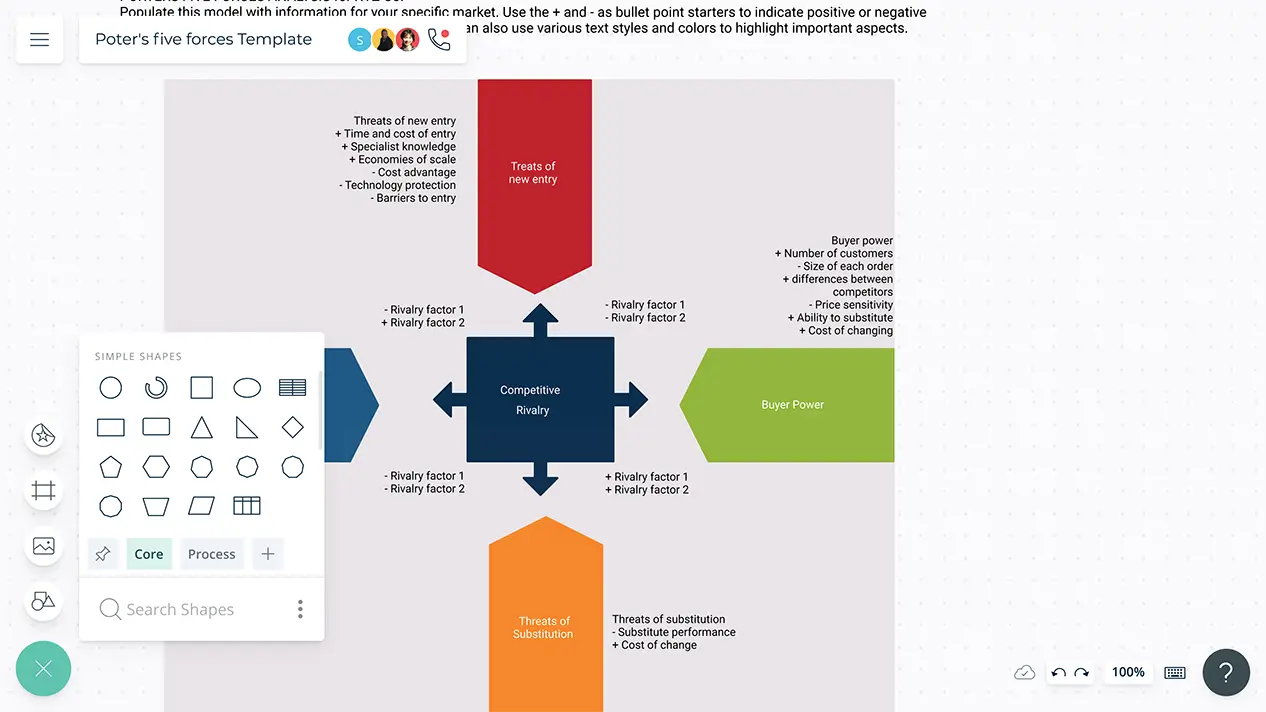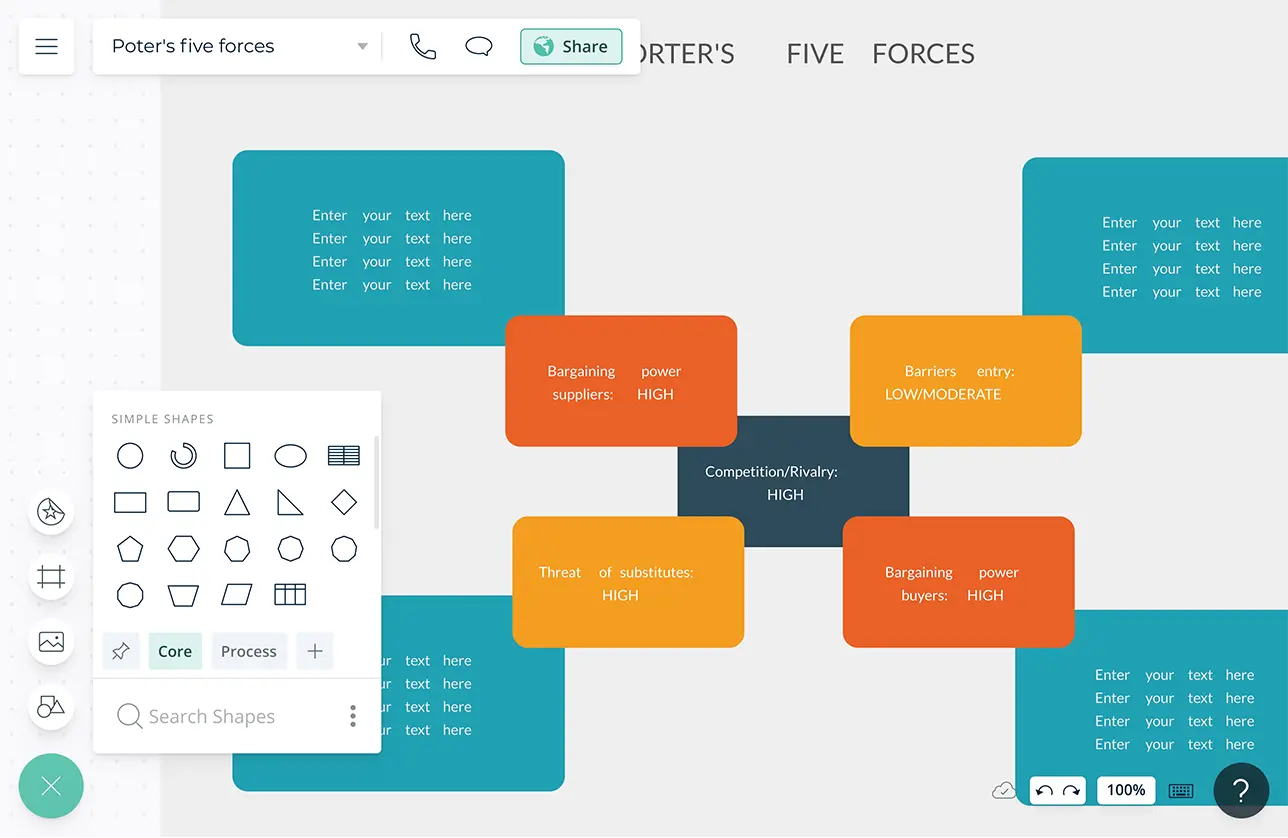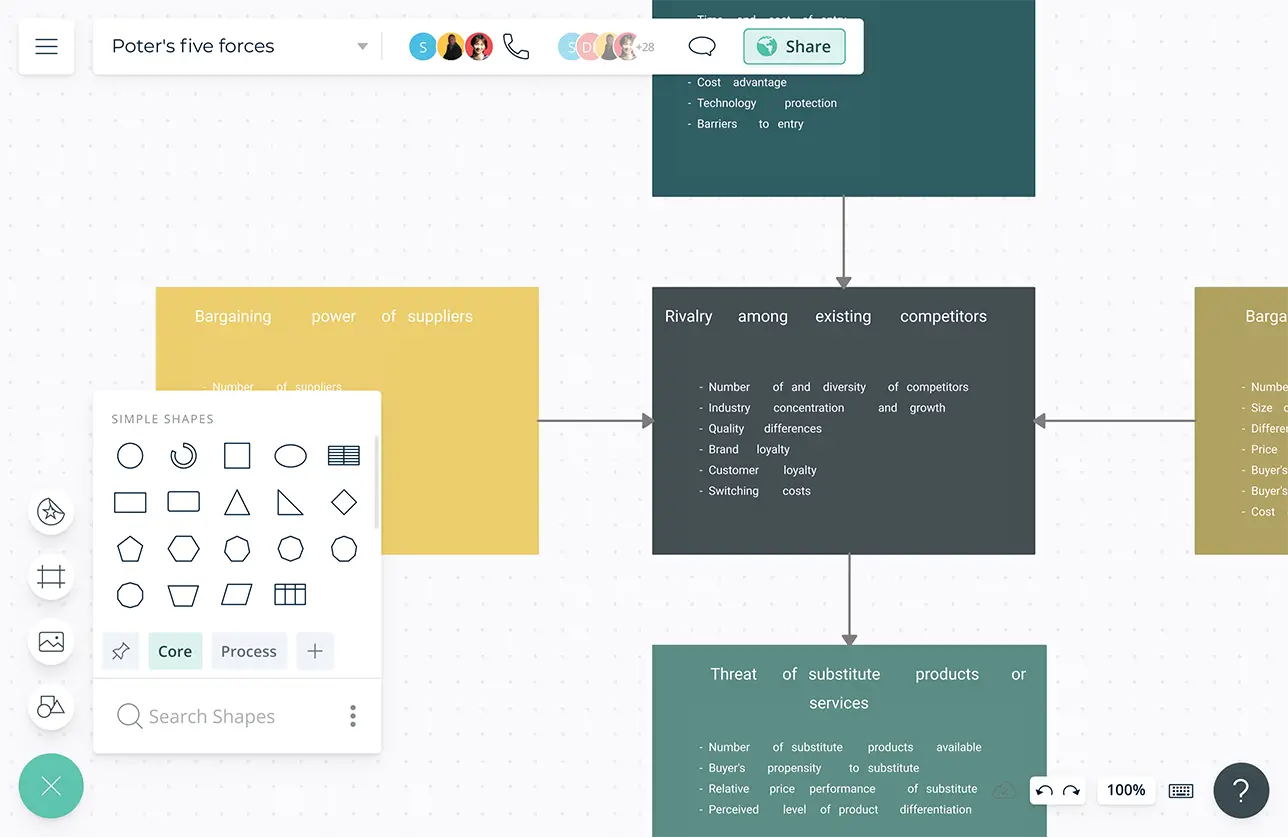Porter’s Five Forces Model Template
Understand Your Competitive Forces
A single, connected workspace with built-in visual tools to get a deeper understanding of competitive forces and formulate strategies to rival them.
- Multiple strategic frameworks and templates to uncover insights into competitive forces at play
- Real-time visual collaboration to brainstorm around creating value for customers
- Easy-to-use visual canvas to map out your vision for the future and share with stakeholders

- Multiple strategic frameworks and templates to uncover insights into competitive forces at play
- Real-time visual collaboration to brainstorm around creating value for customers
- Easy-to-use visual canvas to map out your vision for the future and share with stakeholders


Discover Opportunities for Competitive Advantage

Import competitor, customer, and supplier research data along with industry and environmental factors from external sources to visualize on the canvas for easier analysis.
Import images and vectors to the canvas and embed documents with in-app previews to provide more context with relevant resources.
Notes to add detailed docs, attachments, links and more on each item to capture details and the big picture in a single space.
Create custom databases for any kind of information from competitor and customer profiles to market research and product roadmaps.
Create Strategies to Capitalize on Strengths

Multiple strategy frameworks and templates to get started; SWOT, Ansoff Matrix, Scenario Planning, Strategic Grouping, BCG Matrix, and many more.
Configurable color themes and formatting capabilities to highlight the size and scale of each competitive force in favor of and against you.
Whiteboard with freehand drawing to assist with visualizing strategies and freehand note taking during meetings and brainstorming sessions with stakeholders.
Use frames inside the infinite canvas to split canvas into action plans, Kanban boards, timelines, grids, and more to organize your strategic marketing projects.


Make Fact Based Business Decisions Together

Built-in video conferencing to get instant feedback from your teams, virtually from anywhere.
Use @mention comments to have discussions and follow ups on the same canvas.
Real-time cursors for any number of participants. Work with your team on a shared canvas.
Get Stakeholders on Board with Your Vision

Multiple access levels and roles to streamline managing, sharing, editing, and reviewing strategies.
Multiple integrations to easily connect with popular platforms like Github, Slack, Google Workspace, Confluence, and more.
Smart notifications to stay up to date with changes made on your plans.
Built-in tools to create dynamic and interactive presentations, reports, and dashboards for stakeholders.

What Is Porter’s Five Forces Model?
Porter’s five forces model is a strategic framework that helps organizations understand the intensity of competition in an industry, its attractiveness and profitability level. The model focuses on a set of five factors that help understand the competitive strength and the market position of an organization. The 5 forces are; threat of new entrants, threat of substitutes, bargaining power of suppliers, bargaining power of buyers, and intensity of competitive rivalry.
How to Use Porter’s Five Forces?
- 1. Define the Industry: Start by defining your industry or market. This involves specifying the products or services offered and identifying the target customer base. Clarity in industry definition is crucial for a focused analysis.
- 2. Identify Key Players: List the main competitors and key players in the identified industry. It’ll help you understand the existing landscape and provide a foundation for evaluating competitors.
- 3. Evaluate New Entrants: Analyze the threat of new entrants. Take into account factors like entry barriers, economies of scale, and brand loyalty. New players may be deterred by high barriers, like capital requirements and brand recognition.
- 4. Analyze Buyer and Supplier Power: Analyze the bargaining power of buyers (customers) and suppliers within the industry. Analyze the factors that influence buyer decisions and the industry’s dependence on certain suppliers. Competitive pricing and terms can affect overall industry dynamics when bargaining power is high.
- 5. Assess Threat of Substitutes: Evaluate the potential for substitute products or services that could fulfill the same needs as those offered by the industry. Consider the availability and attractiveness of alternatives, as well as the ease with which customers could switch to substitutes.
- 6. Analyze Competitive Rivalry: Analyze the level of competitive rivalry among existing players. Analyze the number of competitors, their strengths, and the strategies they employ. Price wars, innovation, or other competitive tactics may result from intense competition.
- 7. Develop Strategies: Formulate strategic plans based on the insights gained from the analysis. A few strategies might include increasing barriers to entry, strengthening relationships with key suppliers and customers, and creating differentiation to reduce the threat of competition.